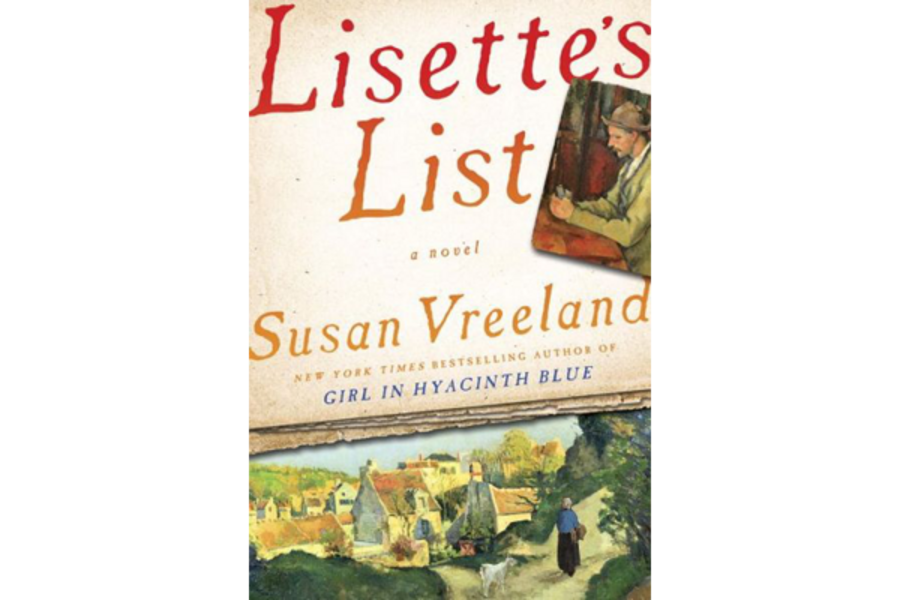'Lisette's List' is aimed at Francophiles and art lovers
Loading...
If you're looking for a good Labor Day weekend beach read – something with a touch of art and culture to ease you back into the fall – Lisette's List, Susan Vreeland's latest novel, could be your book. Vreeland’s writing career was launched with "Girl In Hyacinth Blue," the 1999 bestseller that traces a fictional Vermeer back in time. Vreeland has been creating literary accounts of artworks – “ekphrasis” is the term for this – ever since.
Set in the village of Roussillon, "Lisette's List" should appeal to Francophiles since it is as much a paean to this part of Provence as to the paintings that originated there. Rather than focusing on one artist, it centers on a collection owned by Lisette’s grandfather-in-law. The paintings, which include a Pissarro, a Cezanne, and a Picasso, must be hidden during the Nazi occupation and unearthed (some, literally) after the war.
The concept is promising, though the execution not always as deftly handled as it might be, due to some lack of psychological complexity and a tendency towards neat resolutions.
Pascal, the grandfather, was a frame-maker who traded his wares for the art he loved. Despite his age and failing health, he recalls extensive conversations he had with artists about their paintings before his death in the care of Lisette and her husband André.
Vreeland also incorporates Marc and Bella Chagall, who, as Jews, went into hiding in France, and the playwright Samuel Beckett, who joined the French Resistance in Roussillon – as well as less familiar historical figures, like the head of the Roussillon Resistance, the aptly named Aimé Bonhomme.
Like the heroine of a fairytale, Lisette is an orphan, and "Lisette's List" at times reads like a fairytale with a veneer of adulthood. The title refers to "Lisette's List of Hungers and Vows," which tend to be resolved a bit too neatly, whether “love Pascal as a father” (check) or "do something good for a painter" (she brings the Chagalls food).
The book also tends to “tell” rather than show, an especially tricky choice since Lisette is the narrator. "Was being a witness to the ebbing Pascal's life a means of developing courage for something else to come?" wonders Lisette, and in the next paragraph the Nazis invade Czechoslovakia. Hmm.…
Many men fall in love with Lisette, and while this can be off-putting in and of itself, it is even more so when she’s the one telling us how she’s adored. (Interestingly, this problem appears in many 18th-century novels, which were often narrated by a virtuous female title-character.)
When Lisette relates that André’s friend Maxime engages in a flirtation that “charmed André as much as it did me” (sort of a sanitized “Jules and Jim” –?) it’s hard not to guess how the rest of the novel will unfold. (Spoiler: The two men go off to war, but only one returns.)
The romance that ensues isn't a bad plot device, but its predictability is a problem. Lisette’s lovability can also lead to a certain flatness. André is defined almost solely by his affection for Lisette, and neither he nor their marriage appears to grow or navigate any conflict, even after they have uprooted themselves from cosmopolitan Paris to the countryside. It’s hard to miss André when he’s away fighting or to feel Lisette’s grief.
It’s also hard to stomach when the fictionalized Samuel Beckett confides that he’s “writing a play about waiting.” Beckett’s "Waiting For Godot" is undoubtedly rooted in his wartime experiences, but this idea might have been handled more subtly, especially given the real Aimé Bonhomme’s recollection of Beckett as a man of few words (see a charming youtube interview for this).
On the upside, the novel gains traction when the war ends and characters and relationships are allowed to develop more complexity. The village constable, Bernard, surfaces in this last section as the most interesting and human. A cross between a Byronic hero and the sexually frustrated Judd Fry from the musical “Oklahoma,” his character combines a tragic past with thwarted sexual urges and oddly compromised attempts at virtue. More morally ambiguous than the other unfailingly heroic Rousillonnais, Bernard, like the paintings, remains a bit of a mystery.
The plot also picks up steam as Lisette begins to rediscover the paintings. The answer to the riddle of where they were hidden, by whom, and why is not obvious, though readers may have some inklings. If they persist through some earlier uneven sections, this discovery will make for a satisfying enough ending, especially for those with a taste for a morally just universe where even wartime loss leads to spiritual growth.
Elizabeth Toohey is a professor of English at Queensborough Community College, where she teaches journalism.






